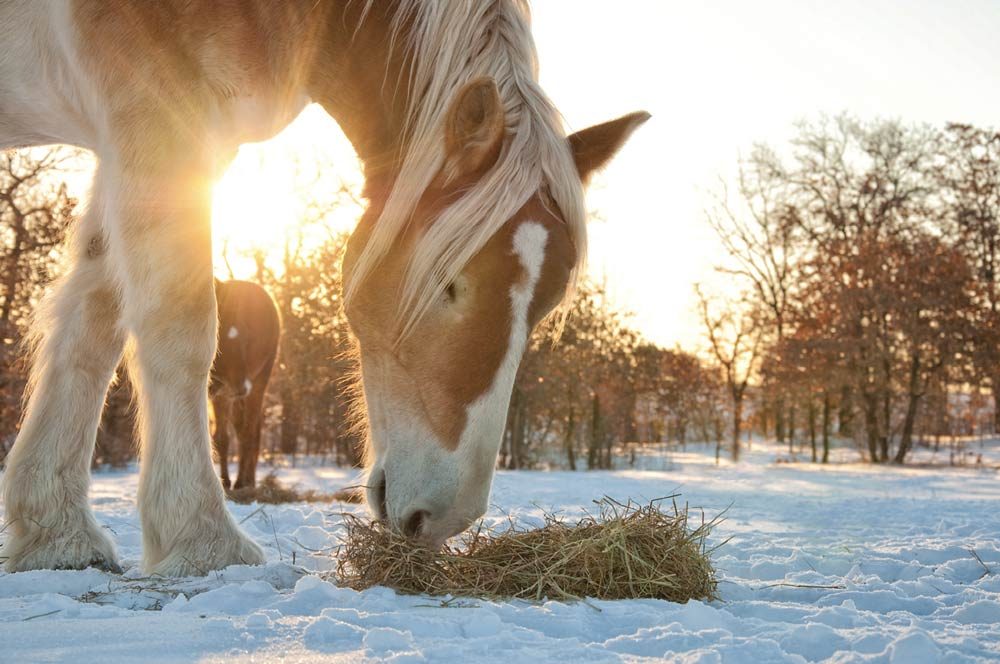Fresh pasture grass is a significant source of nutrition for horses, but its nutritional value diminishes rapidly after harvest — which can be detrimental to winter hoof quality.
“The switch from pasture grass to hay is often the prime factor leading to loss of body and hoof condition,” says Dr. Scott Gravlee, an equine veterinarian and nutrition consultant with Cherokee, Ala.-based Life Data Labs. “The nutritional quality of hay is less than pasture grass, and the quality further diminishes the longer the hay is stored.”
Beta-carotene, which is transformed into vitamin A in the body, is abundant in green forage. Yet, its quality deteriorates more than 50% in a matter of a few days, Gravlee says. Vitamin A is important for healthy skin and hooves. Other vitamins in hay that is in storage deteriorate as much as 7% to 10% a month, he says.
Fresh pasture grasses also play a pivotal role in providing omega-3 fatty acids and phospholipids.
“They add strength and pliability to the connective tissues,” Gravlee says, “and are critical for healthy moisture balance.”
Hay and dormant winter grasses have lower levels of fat — 2% — than fresh grass, which contains 4%.
“That leaves a deficit of 200 grams of fat — or 7 oz. — for an average size horse consuming 10 kg. of dry matter per day,” says Eleanor Kellon, staff veterinarian for Blissfield, Mich.-based Uckele Health and Nutrition. “The hoof wall fats and waxes are all forms that the horse can manufacture from itself from other materials. But when you supplement fat to a horse that’s on a low-fat diet, there is a clear and obvious increase in coat and hoof shine with improved texture.”
Although the fats that are lost help enhance and balance immune system activity, they are also integral for hoof development and protection.
“Hooves are primarily composed of connective tissue,” Gravlee says. “The reduced lipids in the diet during winter hay feeding can lead to weaker hoof structure and poor moisture balance, predisposing the hoof wall to softening and microbial invasions.”
To address the deficiencies that a horse has because of a lack of fresh pasture grass, Gravlee suggests advising that your hoof-care client complement the animal’s diet.
“Feeding the horse a quality hoof supplement that contains a balance of nutrients including fatty acids and phospholipids will provide the needed support for healthy hooves,” he says. “A properly balanced and concentrated nutrient supplement will also help more efficiently metabolize the winter forages and feed.”
When considering supplements, the horse can also benefit from a number of amino acids, vitamins and elements, as well, Kellon says.
“The integrity of the hoof connections, tightness of the white line and immune defenses are also highly dependent on adequate methionine, biotin, copper and zinc,” says the owner of Equine Nutritional Solutions in Robesonia, Pa.
It’s important to note that feeding supplements is not an instant fix. It can take 6 to 12 months before improvements are noticed in the horse’s hooves.
Gain more hoof nutritional insight from Dr. Scott Gravlee of Life Data Labs and Dr. Eleanor Kellon of Uckele Health and Nutrition by reading “Battle Winter Moisture Woes with Nutrition” in the September/October 2020 issue of American Farriers Journal.









Post a comment
Report Abusive Comment